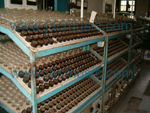Some notes about burning in tubes.
Burning in Tubes.
This is probably why you are here :) Many users have sets of different NOS and new made tubes in use for the same amplifier, and found they all sound different. Let me tell you about burn in. There is something very important, making NOS tubes better than new production.
 NOS tubes, they were initially burned in, decades ago. This was done professional, which means slow, and long enough. Much unlike today’s new production, where tubes are burned in fast, quick, and when they work, they are sold as is. Even so, cathode chemistry is adapted, (adding more Strontium), to make burn in go faster, and more predictable. BUT.... this trick is on cost of the life time. Do you want life time, you can’t do it that way. This (fast burn in) cathode coating is called triple carbonate, and it is the most used today, in all big factories. This can be done, because today tubes are not used any more in apparatus on a daily base anyway.
NOS tubes, they were initially burned in, decades ago. This was done professional, which means slow, and long enough. Much unlike today’s new production, where tubes are burned in fast, quick, and when they work, they are sold as is. Even so, cathode chemistry is adapted, (adding more Strontium), to make burn in go faster, and more predictable. BUT.... this trick is on cost of the life time. Do you want life time, you can’t do it that way. This (fast burn in) cathode coating is called triple carbonate, and it is the most used today, in all big factories. This can be done, because today tubes are not used any more in apparatus on a daily base anyway.
With new production, the user must hope they burn in nice, becoming good tubes, and when not, bad luck. This is why NOS tubes are so much better.
However burn in disappears over the years of storage. Every year you can loose a few %. With some other tubes, they stay as is. But this has nothing to do with quality. Then, if burn in has fully disappeared, the tubes test not really great any more. That means they test not bad, but they are somewhat off specs, randomly. Or from a lot, a few seem to test weak. However they will return to the strong condition just by using them. Which process we call.... BURN IN.
What really happens, the NOS tube which comes out of the box, and test data is just so so. After 50...500 hours, they perform nicely up to data sheet specifications again. How come we can say this? Well this was performed with this tube 50 years ago, and because it did perform indeed, it was not scrapped. So all we do now, is repeat this process, of which a good outcome can be expected. This differs totally from new production which was not tried to burn them in to data sheet specs nicely.
Burning in tubes with the AT1000 tube tester
Burning in tubes with our burn in device
Conclusion
WIth NOS tubes, burn in will take 50...500 hours. Initially they may even test weak, which has nothing to say. They will develop. Do not force burn in to happen by a longer "on" time. Switch the equipment just normally on and off, because the cold periods are needed as well, not just for the mechanical parts to settle better, but also for the chemistry of the cathode. If cold and "off" that does not mean there is no chemistry taking place. There is still a process called diffusion. We can't repeating it often enough, for burn in, all you need to do, use the equipment like normal. A few hours on, and then off for the rest of the day. If at 3 hours per day, that will give 500 hours after 5 months... This is how long it can take. Never judge your NOS tubes before that. After all you purchased not "used" tubes, but NOS tubes.
One last note... A most remarkable thing with burn in is, for the greater part of the time needed, very little will happen. Then, one day you turn the amplifier on, and by surprise the burn in is done! You will say: Now the tubes suddenly sound so well. This is normal, and you just need to give it the required 50..500 hours.